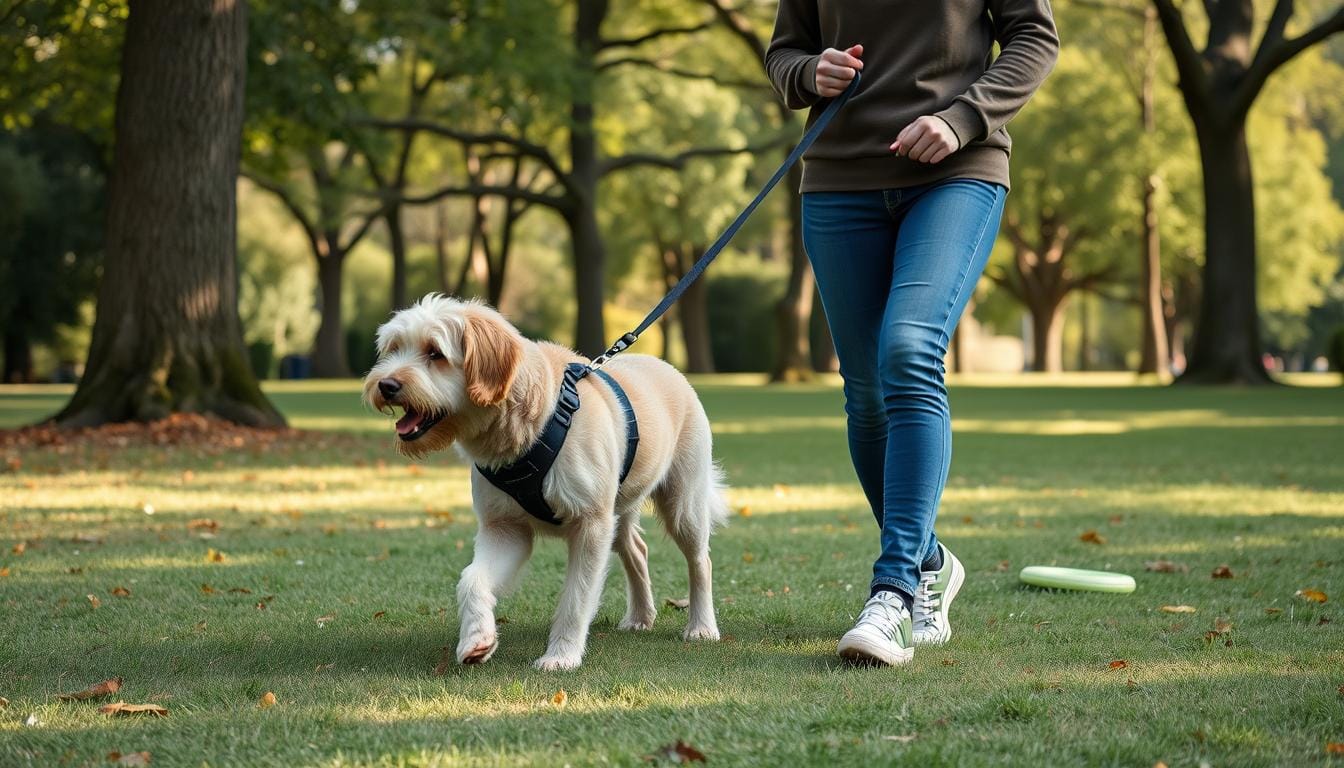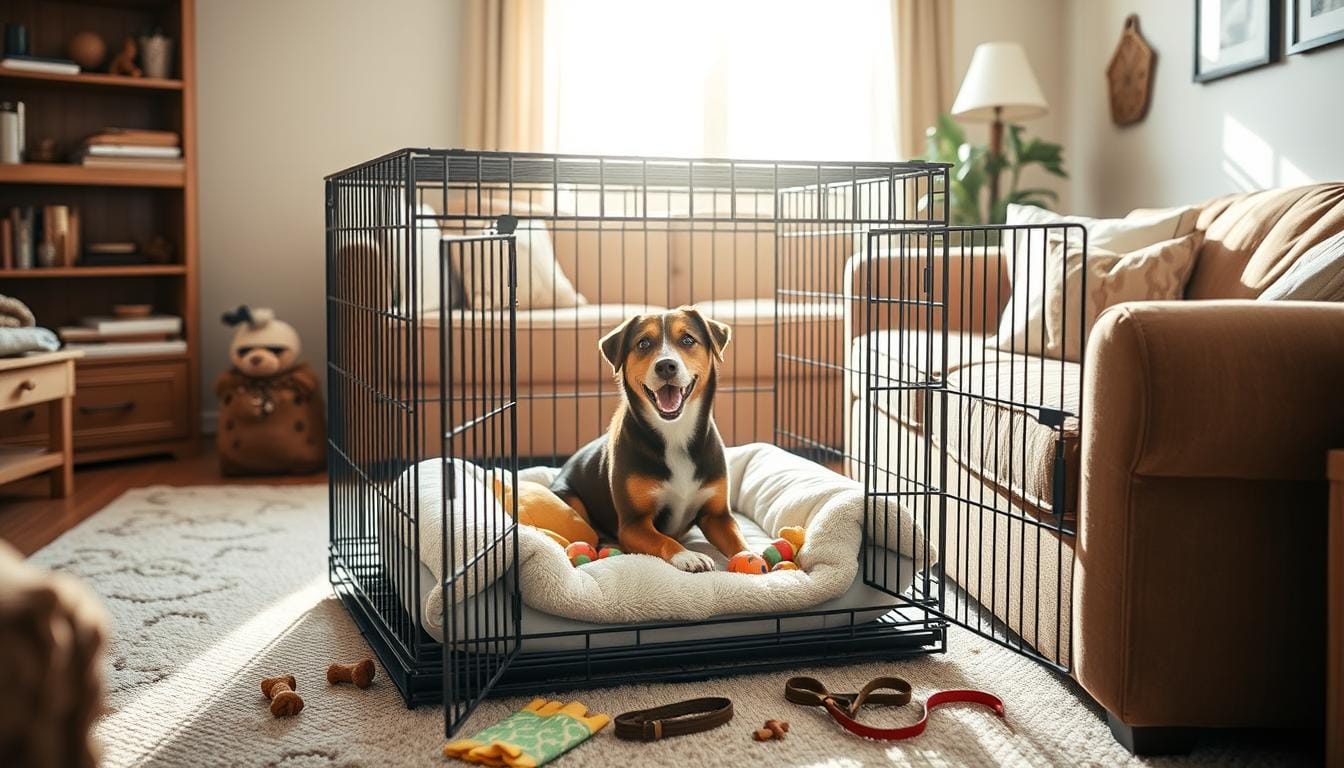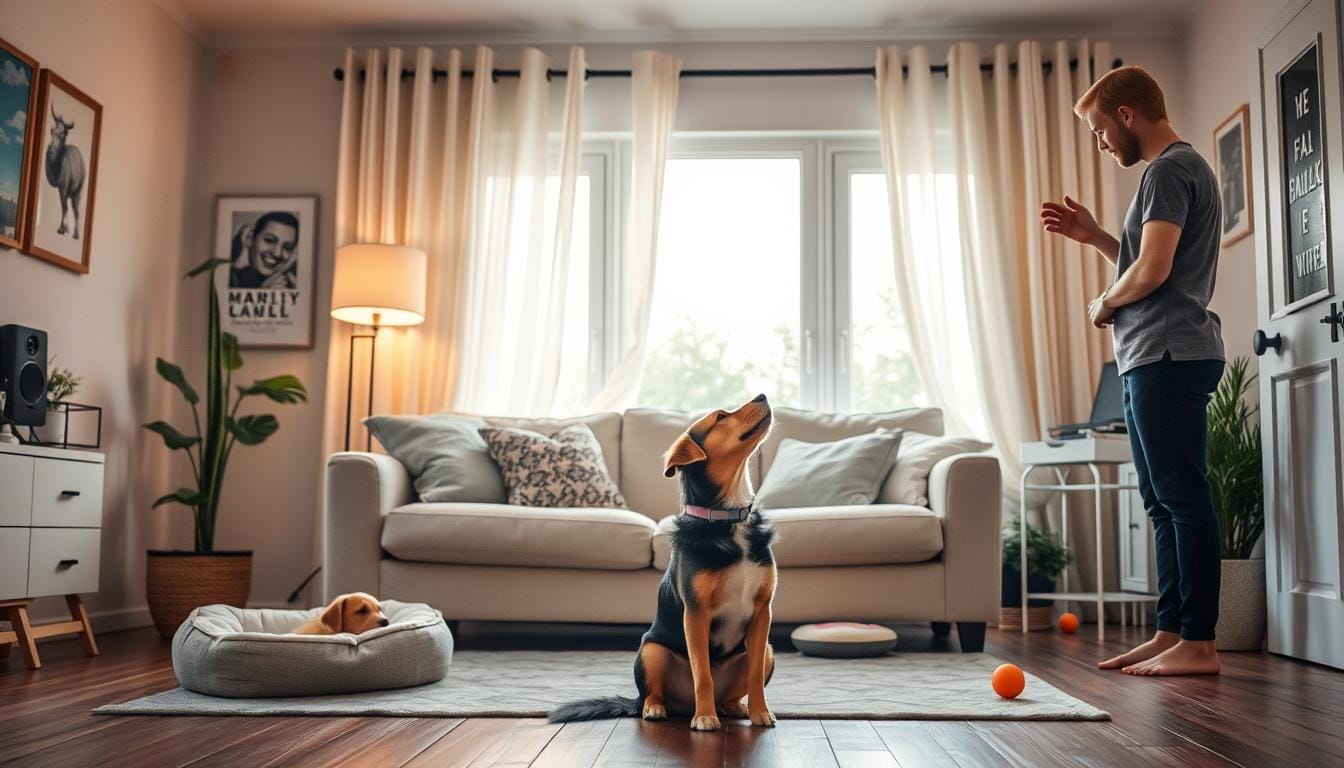What makes the Poodle special? Their unique coats and regal look have won many hearts over the years. Originally from Germany, they were bred to retrieve water. Their smarts and adaptability have made them a favorite in the U.S. Let’s explore what makes them such great companions.
Poodles come in three sizes: Standard, Miniature, and Toy. This makes them perfect for different homes. Their coat is hypoallergenic, needing regular grooming but sheds little. This makes them ideal for those with allergies. They’re also super smart, often working as service dogs, guide dogs, and even truffle hunters.
Poodles are very active and love to be around people. They need lots of exercise and mental games. Their quick minds and desire to please make them great at dog sports and agility. In fact, they even competed in the Iditarod sled dog race, showing their toughness and endurance.
Key Takeaways
- Poodles originated in Germany as water retrievers
- They come in three sizes: Standard, Miniature, and Toy
- Poodles have hair, not fur, which requires regular grooming
- They are highly intelligent and versatile working dogs
- Poodles need regular exercise and mental stimulation
- They excel in various roles, including service and therapy work
Introduction to the Poodle Breed
The poodle is a breed with a rich history that has won hearts around the world. We’ll look at how this smart dog went from its early days to becoming a favorite in the United States.
Origin and History
Many think poodles come from France, but they actually started in Germany. The name “poodle” comes from the German word “pudelin,” which means “to splash in water.” This shows they were once used to help hunters by retrieving waterfowl.
In France, they’re called “Caniche,” or “duck dog.” This name also points to their hunting background.
Breed Recognition
Poodles were recognized as a distinct breed thanks to their unique look and skills. The American Kennel Club (AKC) recognized them in 1887. This was a big moment in poodle history.
This recognition helped poodles become a well-known part of the world of purebred dogs.
Popularity in the United States
Poodles quickly became popular in America. They were the AKC’s most registered breed from 1960 to 1982. Their smarts, hypoallergenic coat, and friendly nature made them a hit.
Today, poodles are still among the most loved breeds in the U.S., often in the top 10.
- Standard Poodles stand 18-24 inches tall
- Toy Poodles weigh between 4.4-6.6 pounds
- Poodles come in various colors, including white, black, and apricot
- They typically live 12-15 years
The poodle’s journey from a German water retriever to a beloved pet shows their ability to adapt and their lasting charm. As we explore more about poodles, we’ll see why they’re so loved by dog enthusiasts everywhere.
Physical Characteristics of Poodles
Poodles are unique among dog breeds. They have a square body, long neck, and proud stance. Their heads are well-shaped, with dark oval eyes and long, wide ears.
Their coat is their most striking feature. Poodles have hair, not fur, making them hypoallergenic. This curly coat comes in white, black, silver, and red.

- Standard: Over 15 inches tall, weighing 45-70 pounds
- Miniature: 10-15 inches tall, weighing 15-17 pounds
- Toy: Up to 10 inches tall, weighing 6-9 pounds
The American Kennel Club lists 12 poodle colors. Their coat needs regular grooming. They need haircuts every 4-6 weeks and brushing 2-3 times a week.
| Poodle Size | Height (inches) | Weight (pounds) |
|---|---|---|
| Standard | Over 15 | 40-70 |
| Miniature | 10-15 | 10-15 |
| Toy | Up to 10 | 4-6 |
Poodles live long lives, up to 12-14 years. The oldest poodle, Chichi, was a toy poodle who lived to be 24!
Poodle Sizes: Standard, Miniature, and Toy
Poodles come in three sizes: standard, miniature, and toy. Each size has its own traits. Let’s look at what makes each one unique.
Standard Poodle
The standard poodle is the biggest. They are over 15 inches tall and weigh 40-70 pounds. They live 12-15 years and need 1-2 hours of exercise daily.
Miniature Poodle
Miniature poodles are in the middle. They are 10-15 inches tall and weigh 10-15 pounds. They live 13-15 years and need 30-60 minutes of exercise.
Toy Poodle
The toy poodle is the smallest. They are under 10 inches tall and weigh 4-6 pounds. They live 12-18 years and need 30-45 minutes of exercise.
| Poodle Size | Height | Weight | Lifespan | Daily Exercise |
|---|---|---|---|---|
| Standard | Over 15 inches | 40-70 pounds | 12-15 years | 1-2 hours |
| Miniature | 10-15 inches | 10-15 pounds | 13-15 years | 30-60 minutes |
| Toy | Under 10 inches | 4-6 pounds | 12-18 years | 30-45 minutes |
All poodle sizes are smart and easy to train. They are calm and friendly. Owners need to keep them active with walks or playtime.
The Iconic Poodle Coat and Grooming
Poodles are famous for their unique coats. They need regular grooming to stay healthy and look good. Unlike most dogs, Poodles have hair, not fur. This makes them a favorite among hypoallergenic dog lovers. Their hair also requires special care.

There are many grooming styles for Poodles, each with its own purpose. The Lion Cut looks like a lion’s mane, while the Puppy Cut is easy to keep up. Show dogs often get the Continental Clip or English Saddle Cut, but these need more work.
Getting a Poodle groomed by a pro is key. How often you need to go depends on the coat type:
- Curly-haired: Every 6-8 weeks
- Wavy-haired: Every 8-12 weeks
- Straight-haired: Every 10-12 weeks
Using the right tools is important for grooming a Poodle. You’ll need grooming scissors, slicker brushes, electric clippers, and whitening shampoo. Different blades can create short puppy cuts or longer styles.
Keeping up with daily grooming stops mats. Regular ear cleaning and nail trimming are also important for health. Even though their coats need a lot of work, Poodles are smart and fun. They’re great companions, despite the grooming needs.
Poodle Temperament and Personality Traits
Poodles are known for their amazing personality and temperament. These intelligent dog breeds have won the hearts of dog lovers for centuries. They are smart and charming.
Intelligence and Trainability
Poodles are among the smartest dogs, showing great intelligence and trainability. They learn quickly, doing well in obedience and advanced skills. Poodles love positive feedback and praise, making them great for new dog owners.
Social Nature
Poodles are friendly and make great family pets. They sense their owner’s mood and bond strongly. They usually get along with other pets if socialized well, making them perfect for families.
Energy Levels and Exercise Needs
Poodles have lots of energy and need regular exercise to be happy and healthy. Activities like fetch, jogging, or swimming are good. They also need mental challenges to avoid boredom and bad behavior.
| Poodle Size | Energy Level | Exercise Needs | Living Space |
|---|---|---|---|
| Standard | High | 60+ minutes daily | House with yard |
| Miniature | Very High | 45-60 minutes daily | House or large apartment |
| Toy | Moderate to High | 30-45 minutes daily | Apartment suitable |
Knowing about poodle temperament helps create the right home for them. With the right care, exercise, and mental challenges, poodles become loyal and loving friends for many families.
Health Considerations for Poodles
Poodles are generally healthy dogs, living up to 12 to 15 years. But, they face certain health issues that need attention. Knowing about poodle health and proper care can help prevent or manage these problems.
https://www.youtube.com/watch?v=H89QQfXtc-k
Dental disease affects about 80% of dogs by age two. Regular teeth cleaning and vet visits are key for their oral health. Eye issues like glaucoma and cataracts are also common, so eye exams are important.
Endocrine system disorders are a big risk for poodles. These include Addison’s syndrome, Cushing’s syndrome, hypothyroidism, and diabetes mellitus. Hypothyroidism is especially common in poodles and they need lifelong hormone supplements.
| Health Issue | Prevalence | Onset Age |
|---|---|---|
| Dental Disease | 80% of dogs | By 2 years |
| Addison’s Disease | Common in Poodles | Around 4 years |
| Hip Dysplasia | More common in Standard Poodles | As early as 5 months |
Bone and joint problems like luxating patella, hip dysplasia, and elbow dysplasia can affect poodles. Hip dysplasia can show signs in puppies as young as five months old. Standard poodles are also prone to epilepsy, with seizures starting between six months and three years of age.
Proper dog care, including regular vet check-ups, a balanced diet, and enough exercise, can help manage these health issues. This ensures a long, healthy life for your poodle.
Poodle: The Versatile Working Dog
Poodles have a long history as working dogs, starting in Germany. They were bred for water work, like duck hunting. Their special coat kept them warm and afloat in the water.
Hunting Origins
The name “Poodle” comes from the German word “Pudel,” meaning “to splash.” In the 15th century, they were valued for their smarts and hunting skills. Their unique haircut helped protect them while swimming.
Modern Roles and Jobs
Today, Poodles do more than just hunt. They are service dogs, therapy dogs, and even compete in dog sports. Standard Poodles are especially good at therapy and service work because of their intelligence and caring nature.
Poodles are versatile in many areas:
- Agility and obedience competitions
- Search-and-rescue operations
- Assistance dogs for people with disabilities
- Therapy dogs in healthcare settings
- Circus performers (historically)
They are smart and adaptable, making them perfect for many jobs. Some Poodles have won many titles, showing their wide range of skills.
| Role | Description | Notable Achievement |
|---|---|---|
| Therapy Dog | Providing comfort in healthcare settings | Peter the Great, a Standard Poodle, has served in a memory-care unit for 7 years |
| Hunter | Retrieving game and participating in hunting trials | Clapton became the first Conformation Grand Champion Poodle with a Master Hunter title in 2021 |
| Service Dog | Assisting individuals with disabilities | Poodles excel in tasks requiring high intelligence and trainability |
Training and Socialization Tips for Poodles
Training and socializing poodles is essential for a well-behaved pet. They love positive reinforcement, making training a fun activity. Start training between 7 and 14 weeks to help them grow into confident adults.
Keep training sessions short and fun. Ten-minute sessions throughout the day are effective. Use treats and praise to reward good behavior. Consistency is key, so use the same words and tone.
Mental stimulation is as important as physical exercise. Mix up training with puzzle toys and games. This keeps your poodle engaged and happy.
Dog socialization is crucial for poodles, who can be shy around strangers. Gradually introduce them to different people, places, and dogs in safe settings. Structured classes provide a controlled environment for socializing.
Even adult poodles can benefit from socialization. It boosts their confidence and improves behavior. With patience and positive experiences, your poodle will become a happy and well-rounded companion.









